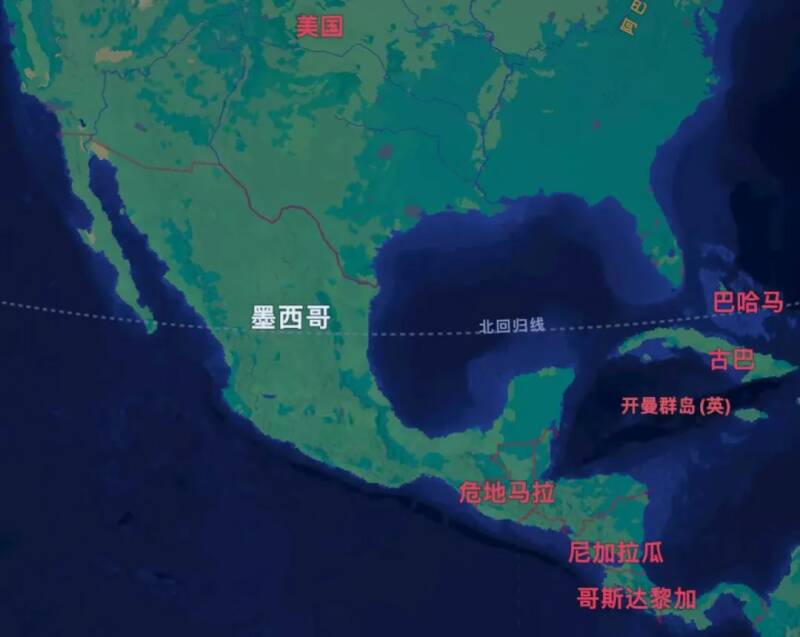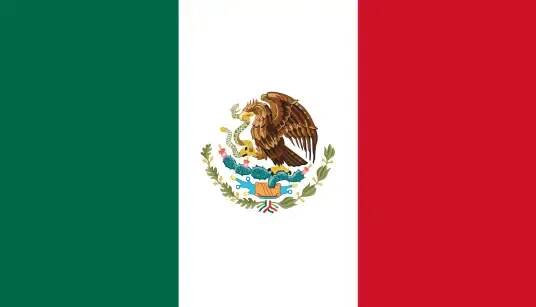Introduction to varieties grown in Mexican coffee producing areas in North American countries
In North America, there are many well-known coffee producing countries, such as Guatemala, Panama, Costa Rica, Jamaica and so on. Mexico is less well-known than other coffee producing countries, but it has also performed well in recent years.
Mexico Mexcio
The United States of Mexico (United Mexican States) is located in the southern part of North America, the northwestern tip of Latin America, bordered by the United States in the north, Guatemala and Belize in the south, the Caribbean Sea in the east and the Pacific Ocean in the west. With a land area of 1.9644 million square kilometers, it is the third largest country in Latin America.

The Mexican flag is rectangular and consists of three parallel vertical rectangles of green, white and red from left to right, in which green symbolizes independence and hope, white symbolizes peace and religious belief, and red symbolizes national unity.
Mexico's national emblem is painted in the middle of the flag. The national emblem shows an eagle spreading its wings with a snake in its mouth, one claw holding the snake and the other on a cactus growing on a rock in the lake. The content of the national emblem comes from the legend of Mexican history, and the cactus is the national flower of Mexico, symbolizing the Mexican nation and its indomitable fighting spirit. At the bottom of the pattern are the branches and leaves of oak and laurel, symbolizing strength, loyalty and peace.

Mexico is surrounded by the Madre Mountains on the east, west and south, with the Mexican plateau in the center and the flat Yucatan Peninsula in the southeast, while most of the coastal areas are long and narrow plains, with the famous Twantepec isthmus and Central America.
Mexico has a complex and diverse climate. Due to its many highlands and mountains, the plateau is mild all the year round, with an average temperature of 10-26 ℃. The northwest interior has a continental climate, the coastal and southeastern plains have a tropical climate, and the south has a tropical rain forest climate. Most areas are divided into two seasons: drought (October-April) and rain (May-September). Mexico is well suited for coffee cultivation because of its diverse climate, fertile volcanic soil, suitable temperature and high altitude.
Coffee producing area
There are more than 500,000 producers in the country, of which more than 95% are small growers with less than 2.83 hectares of land. Planting is distributed in 16 states, although more than 90% are distributed in the four main producing areas in the south: Chiapas, Oaxaca, Veracruz, Veracruz, and Puebla, Puebla.
Chiapas, Chiapas: Chiapas is located at the southernmost tip of Mexico, on the border of Guatemala. Boutique coffee is grown between 1300 and 1700 meters and has 178000 farmers, mostly small-scale family farmers. It is the largest coffee-producing state in Mexico. Coffee is grown in nine parts of Chiapas, of which Selva Region is the largest in the northeast and Soconusco Region in the southernmost.
Oaxaca, Oaxaca: Oaxaca is located in the northwest of Chiapas, and the western part of the state is near the Pacific Ocean. Coffee farms are generally 90-1650 meters above sea level, but the state's coffee production technology is relatively backward.
Veracruz Veracruz: Veracruz is also located in the northern state of Oaxaca, near the Caribbean, and coffee is grown in mountains 1100-1600 meters inland. Veracruz is currently the most technologically advanced, and many disease-resistant varieties are grown in the state.
Puebla State Puebla: Puebla State, located southeast of the country's capital Mexico City, is home to the famous active volcano Popocatepeter volcano. The coffee produced here is affected by altitude and volcanic soil, and has a more complex coffee flavor.
Coffee variety
The main varieties of Mexican coffee include: Typica, Bourbon Bourbon, Kaddura Caturra, Maragogype, Pacamara, Garnica, New World Mundo Novo, Rosa Gesha and so on, of which the more special is Garnika Garnica.
Garnica:Garnica is a cross between Mundo Novo and Caturra. It was developed by the Mexican Coffee Institute (INMECAF É) in the 1960s and is similar to Catuai.
Important Notice :
前街咖啡 FrontStreet Coffee has moved to new addredd:
FrontStreet Coffee Address: 315,Donghua East Road,GuangZhou
Tel:020 38364473
- Prev

The government officially takes over FNC! Colombia's coffee industry ushers in major reforms
Recently, the Colombia coffee industry is facing a series of challenges and threats, including prices, weather, political systems, etc. In addition to weather problems, the biggest problem with Colombia coffee lies in the government's system. Earlier, the Colombia Coffee Growers Council (FNC) complained against the government, arguing that the government had not
- Next

The heat has passed! Fresh fruit coffee shops have disappeared in large areas!
▲ Click to pay attention| Daily Boutique Coffee Culture Magazine Coffee Workshop Recently, more and more netizens have discovered that all fresh fruit coffee brands around them have been closed. Some have been reducing the number of stores and slowly disappeared from public view. Some have closed their stores and withdrawn shortly after landing, leaving signs that have not yet been removed. These fruit and coffee brands are
Related
- What effect does Italian American coffee with filter paper have? Will coffee taste better if it is put on filter paper at the bottom of the powder bowl?
- What is the color difference in coffee beans? What are the characteristics of honey processed coffee beans? Why are the anaerobically treated coffee beans uneven in color?
- How does novice Xiaobai quickly get started and make coffee? Newbies learn to make coffee by hand and share the specific steps and process process!
- Costa tea has a shelf life of 100 years?! Expert: Unable to verify
- It's a huge uproar! American milk addition was rejected by Manner employees?!
- Mocha pot coffee bean recommendations| How fine and how much powder should be used for grinding? What parameter ratios do I need to use to make milk with Mocha pot coffee?
- What are the characteristics of the world's top ten coffee beans treated with Costa Rica honey? How to make black honey kadura from Tarazhu Pilon Processing Plant taste good?
- How to make deep-roasted coffee? What grinding water temperature does authentic Jamaica Blue Mountain No. 1 coffee use to brew it well?
- Selected high-grade rose summer coffee flavor tasting guide Why Panama rose summer has the aroma of flowers and fruits
- What equipment does a novice Xiaobai need to buy to learn to make coffee? Filter cup electronic scale bean grinder manual flushing pot purchase guide

